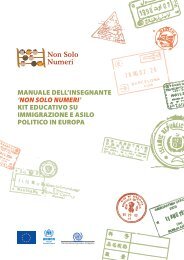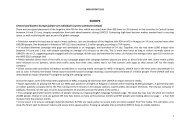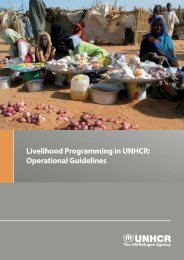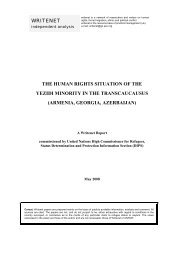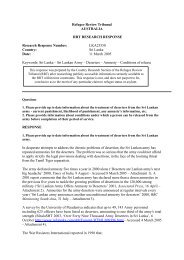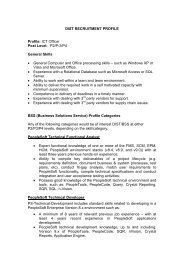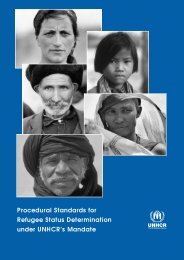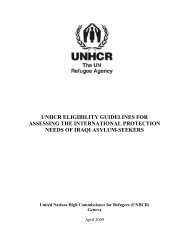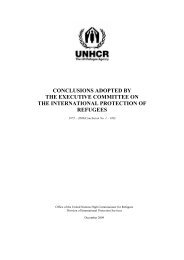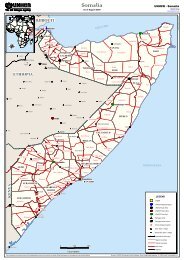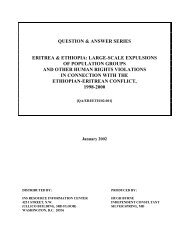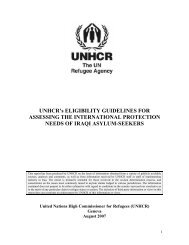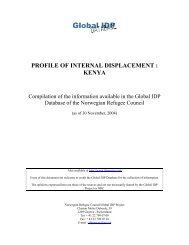The Batwa Pygmies of the Great Lakes Region - UNHCR
The Batwa Pygmies of the Great Lakes Region - UNHCR
The Batwa Pygmies of the Great Lakes Region - UNHCR
Create successful ePaper yourself
Turn your PDF publications into a flip-book with our unique Google optimized e-Paper software.
NOTES<br />
Author’s Acknowledgements – <strong>The</strong> author would like<br />
to thank Dr James Woodburn and <strong>the</strong> following organizations<br />
for <strong>the</strong>ir support and assistance: Forest Peoples<br />
Program – World Rainforest Movement (UK),<br />
Emanzi Food, Peace and Development (Uganda),<br />
CAURWA (Rwanda), Christian Aid (Burundi), Save<br />
<strong>the</strong> Children Fund (Burundi), World Vision (Burundi),<br />
ADPH, UCEDD, UNIPROBA (Burundi), and all <strong>the</strong><br />
<strong>Batwa</strong> who so patiently gave <strong>the</strong>ir time to explain <strong>the</strong>ir<br />
situation to <strong>the</strong> author.<br />
1 <strong>The</strong> term Pygmy should be spelt in English with a capital<br />
P. Like Gypsies and Bushmen, <strong>Pygmies</strong> are rarely<br />
attributed <strong>the</strong> capital letter that designates a people’s<br />
proper name.<br />
2 During MRG fieldwork <strong>Batwa</strong> in Uganda did not call<br />
<strong>the</strong>mselves Abayanda, only <strong>Batwa</strong>. <strong>The</strong> Basua <strong>of</strong> <strong>the</strong><br />
Ugandan Ruwenzoris are related to <strong>the</strong> Bambuti ra<strong>the</strong>r<br />
than <strong>the</strong> <strong>Batwa</strong>.<br />
3 Following this convention, Hutu and Tutsi are referred<br />
to in this report as Bahutu and Batutsi.<br />
4 <strong>The</strong> widespread use <strong>of</strong> this term by Bantu speakers<br />
across Central Africa is shown in <strong>the</strong> number <strong>of</strong> different<br />
Pygmy groups referred to as <strong>Batwa</strong>, Bacwa and by<br />
o<strong>the</strong>r similar names. <strong>The</strong> nature <strong>of</strong> relations between<br />
<strong>the</strong> <strong>Batwa</strong> <strong>of</strong> <strong>the</strong> <strong>Great</strong> <strong>Lakes</strong> <strong>Region</strong> and o<strong>the</strong>r Pygmy<br />
groups with similar names outside this region are<br />
unclear from existing research. Schadeberg, T., ‘<strong>Batwa</strong>:<br />
<strong>the</strong> Bantu name for <strong>the</strong> invisible people’, in K. Biesbrouck,<br />
S. Elders and G. Rossel (eds), Central African<br />
Hunter-Ga<strong>the</strong>rers in a Multidisciplinary Perspective:<br />
Challenging Elusiveness, CNWS, Universiteit Leiden,<br />
1999, pp. 21–40, provides an important account <strong>of</strong> <strong>the</strong><br />
distribution and possible derivation <strong>of</strong> <strong>the</strong> term ‘-twa’.<br />
5 Some o<strong>the</strong>r Pygmy groups refer to <strong>the</strong>mselves as<br />
<strong>Batwa</strong>, Batua, Basua, Bacwa, etc. in Central Africa.<br />
<strong>The</strong> <strong>Batwa</strong> groups met by <strong>the</strong> author recognize <strong>the</strong>ir<br />
shared identity with <strong>the</strong> <strong>Batwa</strong> in <strong>the</strong> regions described<br />
in this report. Fur<strong>the</strong>r research is required to clarify<br />
<strong>the</strong> nature <strong>of</strong> relations between <strong>the</strong> different groups<br />
calling <strong>the</strong>mselves <strong>Batwa</strong>, or by similar names, in o<strong>the</strong>r<br />
regions.<br />
6 This estimate is based on available documentation and<br />
interviews with <strong>Batwa</strong> indigenous associations where<br />
possible. Uganda: 4,000 (based on Kabananyuke, K.<br />
and Wily, L., ‘Report on a study <strong>of</strong> <strong>the</strong> Abayanda <strong>Pygmies</strong><br />
<strong>of</strong> south-western Uganda for Mgahinga and Bwindi<br />
Impenetrable Forest Conservation Trust’, unpublished<br />
report, 1996, p. 25). Rwanda: 20,000–27,000 (Lewis, J.<br />
and Knight, J., <strong>The</strong> Twa <strong>of</strong> Rwanda: Assessment <strong>of</strong> <strong>the</strong><br />
Situation <strong>of</strong> <strong>the</strong> Twa and Promotion <strong>of</strong> Twa Rights in<br />
Post-War Rwanda, Copenhagen, World Rainforest<br />
Movement and International Work Group for Indigenous<br />
Affairs, 1995, pp. 92–3, also in French, 1996, and<br />
interview with CAURWA 1999), DRC: 16,000 (PIDP,<br />
1993 and Luling, V. and Kenrick J., Forest Foragers <strong>of</strong><br />
Tropical Africa: A Dossier on <strong>the</strong> Present Condition <strong>of</strong><br />
<strong>the</strong> ‘Pygmy’ Peoples, London, Survival, 1993, p. 25),<br />
Burundi: 30,000–40,000 (based on government estimates<br />
and interview with UNIPROBA 1999).<br />
7 For historical information on <strong>the</strong> dominant groups in<br />
<strong>the</strong> region see D’Hertefelt, M., Trouwborst, A.A. and<br />
THE BATWA PYGMIES OF THE GREAT LAKES REGION<br />
Scherer, J.H., Les Anciens Royaumes de la Zone Interlacustre<br />
Méridionale, Musée Royal D’Afrique Centrale,<br />
Tervuren, 1962, Newbury, C., <strong>The</strong> Cohesion <strong>of</strong><br />
Oppression: Clientship and Ethnicity in Rwanda,<br />
1860–1960, New York, Columbia University Press,<br />
1988, and Vansina, J., Paths in <strong>the</strong> Rainforest: Towards<br />
a History <strong>of</strong> Political Tradition in Equatorial Africa,<br />
London, James Currey, 1990.<br />
8 Schumaker, P., ‘Expedition zu den Zentralafrikanischen<br />
Kive-Pygmaën’,Mémoires de l'Institut Royal<br />
Congo Belge, Section des Sciences Morales et Politiques,<br />
vol. 5, p. 400 recounts that <strong>Batwa</strong> in <strong>the</strong> Bushivu<br />
highlands fought long wars with agricultural peoples<br />
who attempted to clear <strong>the</strong>ir ancestral forest for farms.<br />
Many bloody battles occurred and <strong>the</strong> fighting continued<br />
until around 1918. See also note 9.<br />
9 <strong>The</strong> later section ‘<strong>The</strong> history <strong>of</strong> <strong>the</strong> <strong>Batwa</strong> in Kigezi-<br />
Bufumbira, southwestern Uganda’ provides an example<br />
<strong>of</strong> <strong>the</strong> historical relations between <strong>Batwa</strong> and<br />
newcomers to <strong>the</strong>ir forest. An Album <strong>of</strong> <strong>Batwa</strong> music,<br />
Court Songs for Inanga and Folk Songs by Médard<br />
Ntamaganya (Rwanda) is available on <strong>the</strong> INEDIT<br />
label, Maison des Cultures du Monde, Paris, 1997.<br />
10 See Lewis and Knight, op. cit., 1995, p. 44.<br />
11 Jackson, D., ‘Some recent international initiatives in<br />
Equatorial Africa and <strong>the</strong>ir impacts on forest peoples’,<br />
in K. Biesbrouck, S. Elders and G. Rossel (eds), op. cit.,<br />
pp. 279–90, provides more information on <strong>the</strong> development<br />
<strong>of</strong> <strong>the</strong> indigenous rights associations in Central<br />
Africa and <strong>the</strong> involvement <strong>of</strong> <strong>the</strong> international community.<br />
12 In Barume, K. with Jackson, D., Heading Towards<br />
Extinction? <strong>The</strong> Expulsion <strong>of</strong> <strong>the</strong> Twa from <strong>the</strong> Kahuzi-<br />
Biega National Park, Democratic Republic <strong>of</strong> Congo,<br />
Copenhagen, World Rainforest Movement and Forest<br />
Peoples’ Program, draft 1999, <strong>the</strong> interested reader<br />
will find an extended discussion <strong>of</strong> <strong>the</strong> international<br />
process promoting indigenous rights and <strong>the</strong> <strong>Batwa</strong>’s<br />
history <strong>of</strong> involvement in it. See also Braem, F., Indigenous<br />
Peoples: In Search <strong>of</strong> Partners, with a Consultative<br />
Questionnaire, APFT Working Paper no. 5,<br />
Brussels, 1999 for a more global perspective.<br />
13 <strong>The</strong> World Bank has been developing its policy for<br />
indigenous peoples since 1982, most recently expressed<br />
in Operational Directive 4.20, Indigenous Peoples<br />
(September 1991) and <strong>the</strong> Draft Operational Policy OP<br />
4.10, Indigenous Peoples (19 May 1999). <strong>The</strong> European<br />
Union has two <strong>of</strong>ficial policy documents: Working Document<br />
<strong>of</strong> <strong>the</strong> Commission on Support for Indigenous<br />
Peoples in <strong>the</strong> Development Cooperation <strong>of</strong> <strong>the</strong> Community<br />
and <strong>the</strong> Member States, SEC (1998) 773<br />
PE/98/695, and Resolution <strong>of</strong> <strong>the</strong> EU Council <strong>of</strong> Ministers,<br />
30 November 1998: Indigenous People within <strong>the</strong><br />
Framework <strong>of</strong> <strong>the</strong> Development Cooperation <strong>of</strong> <strong>the</strong><br />
Community and Member States. For <strong>the</strong> UN see Pimbert,<br />
M.P. and Pretty, J.N., Parks, People and Pr<strong>of</strong>essionals:<br />
Putting ‘Participation’ into Protected Area<br />
Management, Discussion Paper no. 57, Geneva,<br />
UNRISD, 1995, in conservation see IUCN/WCPA/WWF<br />
(World Conservation Union/World Commission on Protected<br />
Areas/World Wide Fund for Nature), Principles<br />
and Guidelines on Indigenous and Traditional Peoples<br />
29



